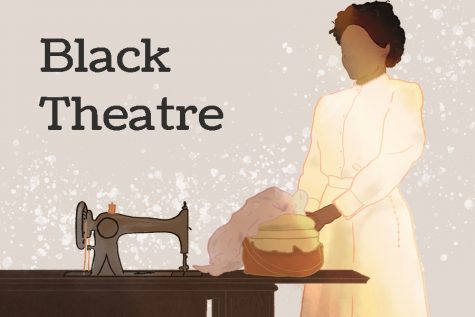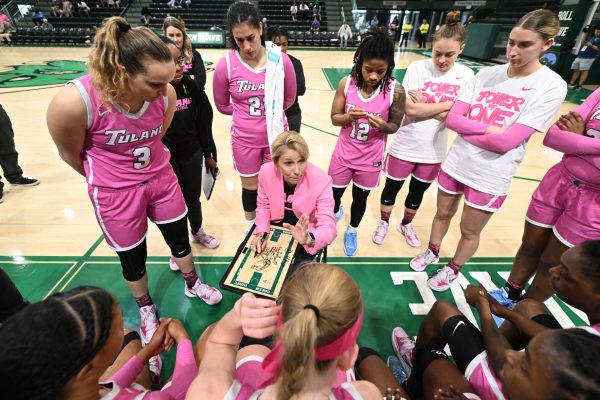Tulane’s Theatre and Dance Department shines spotlight on the magic of black theatre
February 14, 2019

Before it became a business world buzzword, storytelling was a way for people to connect on an emotional level. The theatre has long offered a platform for this connection on a broader scale.
Based on the U.S. education curriculum, Americans generally learn about the history of Western theatre starting with Ancient Greek civilization. There is, however, more to theatre history than just Greek tragedies and Roman dramas.
“In covering Western civilization’s theatre history, you end up covering a lot of white people’s theatre history,” Professor John “Ray” Proctor III said.
Proctor is a faculty member of Tulane’s Department of Theatre and Dance. He is teaching a course on African-American theatre history and another course titled “Theatre for Social Justice” this semester.
“I think [Western theatre history] … has to do with the process of normalization, how we create a definitive text, how we create an authoritative text,” Proctor said. “So all of those things are tied with Western civilization’s notion of history.”
Broadway isn’t only show business; it is big business. American consumers spend almost $32 billion every year for admissions into performing arts events. People love to watch stories play out on a stage. The significance of this art in our culture, however, can raise questions. In particular, whose stories are being told?
“When I’m approaching my writing I use this phrase, which is ‘sustain the complexity,’” Pulitzer Prize-winning playwright Lynn Nottage said during her visit to Tulane this past Saturday afternoon.
Nottage is the first female to win the Pulitzer Prize for Drama twice, famous for her many works, including “Intimate Apparel.”
“I think that the African-American narrative is part of the American narrative and we’ve been so inconveniently erased from that,” Nottage said. “My role is to reinsert us in that story and also to reclaim the story because people forget this is our story as well.”
Traditionally, African cultures have seen storytelling as a captivating way to pass on traditions, beliefs and feelings. These stories are often told through ceremonies, myths and performances, and it has been this way since ancient times. As a result of the transatlantic slave trade, this aspect of African cultures expanded into the U.S., albeit through the cruelty of slavery.
African-American theatre has an unfortunate and dark origin. Minstrel shows began in the early 19th century, gaining notoriety for their mockery of Black Americans through blackface. Essentially, Black theatre was played by white Americans, for white Americans. Later on in the century, Black people began to play those roles in minstrel shows, but the disrespect towards African-American culture and its people continued.
The Harlem Renaissance changed the state of African-American theatre forever. Black theatre companies bloomed across the U.S. in cities like Chicago, Washington, D.C. and the hub of theatre and drama: New York City. Black Americans finally had the resources to be able to tell their own stories, for their own communities. Black-produced plays such as Langston Hughes’ “Mulatto” started becoming hits on Broadway.
“African-American culture, the African side of that hyphen, comes from a culture that has a history of oral tradition,” Proctor said. “Telling stories. How we share stories. But it also includes how we share our past, that’s how our ancestors, how our mothers, how the women told the stories of what they were like when they were little kids … the way we pass our culture, the way we pass our history, the way we pass our senses of identity is through storytelling, it’s through performance.”
Nottage also views storytelling as a tool to look introspectively, and to then share your experiences with others.
“I became acutely aware that as a storyteller, I hadn’t invested into my own personal narrative,” Nottage said. “‘Intimate Apparel’ really became my way of investigating my own ancestry. I went to the New York Public Library and literally spent 2 years trying to reconstruct what it would’ve been like for an African-American woman who lived in New York City at the turn of the 20th century. I want to piece together their story because I thought that’s all I have to cling to. ”
During the ‘60s, African-American theatre shifted to highlight the struggles and injustices of Black Americans, and distinguished itself as more progressive than the works of white Americans at the time. Cultivating a unique and empowering theatre pertaining to an identity flourished. Lorraine Hansberry’s “A Raisin in the Sun” and Amiri Baraki’s “The Dutchman,” two well-known plays that from this era, exemplify this.
“All the cultures that we’ve defined in this country as marginalized get blanched out when we talk about American identity, so this has to do with the American dream and the process of assimilation,” Proctor said. “My reason for arguing for an African-American theatre history course was to reintroduce the specificity of African-American history and culture into its playwriting, into its art creation … the history of America is also the history of race in America … We have to go ‘what is our American history?’”
Today, African-American theatre remains thriving and resilient. Playwrights such as Nottage and Suzan Lori-Parks, also a Pulitzer Prize winner for her play “Topdog/Underdog,” continue to redefine what it means to be Black in America and display the neglected beauty and amazement of African-American culture through theatre.
“Growing up there was such an absence of Black women centerstage, and the mere fact we’re telling our stories and putting those characters right-center I think is a form of activism,” Nottage said. “I also don’t feel that [in] everything that we write race has to be in the center. I think telling beautiful stories about love and about friendship can do even more than telling stories about ‘race’ with a capital ‘R.’”





















Brenda Billizon • Feb 14, 2019 at 1:12 pm
Thanks for the information!! I truly enjoyed this. I would love to go to a play about African American history. Thank you so so much!